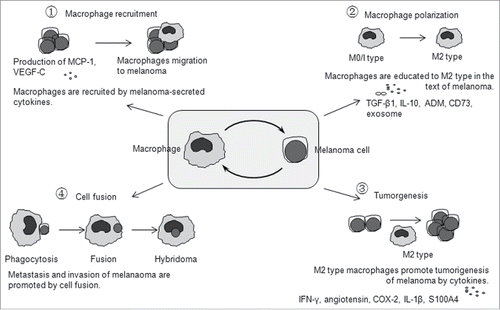Figures & data
Figure 1. Melanoma progression and pro-tumor activities of macrophages. ① Macrophage recruitment to melanoma. Melanomas release many different types of macrophage-recruiting molecules, such as MCP-1 and VEGF-C, to attract macrophage migration to melanoma sites. ② Polarization to pro-tumor M2 type. Macrophages can be induced and educated to adopt a protumoral phenotype (M2) in the text of melanoma, which is co-made up by both melanoma cells and macrophages. ③ Cytokines by macrophages promote tumorigenesis of melanoma. Macrophages recruited to the melanoma can produce melanoma-stimulating molecules such as IFN-γ, angiotensin, COX-2, IL-1β and S100A4 to support the growth and metastasis of melanoma. ④ The cancer cell fusion theory. Macrophages in the melanoma microenvironment can devour melanoma cells, if digestion fails, then would likely form a hybridoma of the macrophage-melanoma cell, that results in metastasis of the melanoma.

